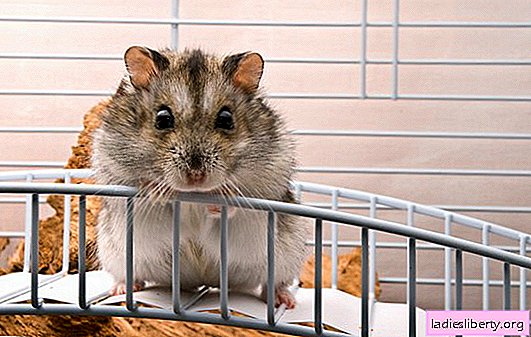
Hamsters: home care. Pros and cons
Before you implement the "want a hamster", you should weigh the pros and cons. It is important to make sure that there is no allergy to the hair, saliva of animals, hygienic fillers in households, determine the place where the cage will stand, arrange with someone who will take care of the animal in case of your departure or illness. Also, don’t give a hamster to people without their consent. Get ready for the fact that if the hamster is bought by a child, then you still cannot avoid participating in the care of the animal.
The advantages of hamsters over other pets are that they:
• take up little space;
• eat little and are unpretentious in food;
• caring for them is simple;
• they do not need to walk;
• inexpensive;
• easy to breed;
• do not create noise in the apartment.
• do not leave countless tufts of wool on furniture, clothes.
Disadvantages:
• without supervision outside the cell, they can “try on the tooth” everything that interests them;
• fall into hibernation in winter - during this period they cannot be disturbed;
• may be aggressive when picked up;
• due to their small size, they are difficult to find if they escaped from the cage and hid;
• with irregular cleaning of the cell, a specific odor appears.
The hamster's lifespan depends on the conditions of detention. On average, they live 2 years.
The best age for a hamster to acquire is 1.5-2 months (during this period they are easier to tame).
Hamsters: home care. How to choose a healthy hamster?
The health criteria of a hamster are its appearance and behavior. A healthy animal has:
• shiny fur without bald patches - bald spots can be caused by stress, subcutaneous ticks, fungal diseases;
• clear clean eyes without any discharge;
• clean anal opening without signs of diarrhea;
• calm, even breathing;
• clean nose without plaque and secretions.
It is better to observe the behavior of the hamster in the late afternoon. In the afternoon, these animals usually sleep. In the evening, healthy hamsters become active, feed, start running and climbing their territory.
Hamsters: home care. Which cage for a hamster to choose: trellised or dune? Cage equipment
In pet stores, the assortment of cells for hamsters is quite wide. They are divided into 2 types: trellised or plastic.
Ordinary trellised cells acquire for the Syrian (golden) hamsters. The rods in such cells should be horizontal. This will allow the animal to climb the walls. The lattice pitch depends on the type of hamster that will live in this cage: for a golden one - up to 1 cm, for smaller species - 0.5 cm. This will not allow the animal to stick its head between the rods and get stuck. The optimal cell parameters for large hamsters are as follows: length - 0.5-0.6 m, width 0.4 m, height 0.3-0.4 m.
Cages, or rather containers with plastic walls (dunes), are convenient for keeping dwarf species of hamsters (Dzhungarsky, Campbell, Roborovsky) - they are not prone to vertical climbing. The minimum size of such a cell is 0.5x0.3x0.25-0.3 m.

Dune for small species of hamsters
Cell equipment
For a comfortable stay of a small pet, his home must be properly equipped.
The health of the animal and the amount of time spent on cleaning the cage will depend on the choice of litter. It is not recommended to use newspapers as bedding - printing ink is harmful to the hamster. In addition, newsprint does not cope with moisture absorption and odor retention.
If you use clean paper or cotton, then again the question of smell remains relevant. In addition, the animal, wrapped with cotton fibers, can overtighten and damage its legs.
In second place in popularity are pressed sawdust, wood shavings or hay. However, hamsters are allergic to pellets from conifers.
The best litter option is corn filler (crushed cobs with a small amount of grain residue). It is small, lightweight, the hamster is comfortable to run on it, the smell holds up to 10 days. Its minus is a higher price compared to other types of bedding.
There should be 2 feeders in the cage: one for solid grain feed, the other for soft (vegetables, fruits, greens).
So that the animal does not throw drinking water in the cage with a filler and does not spill it, it is better to use a car drink. Water should change daily.
To keep fit, the hamster needs to move a lot. Therefore, it is necessary to put a wheel in the cage. It is better to choose solid, with transverse protrusions, so that the hamster does not slip and does not damage the legs. For a variety of "sports activities" the pet will need labyrinths, slides, stairs.

Equipped Hamster Cage
Hamsters have a nocturnal lifestyle and for a day's rest they need a safe place - a mink. As it is placed in a cage house, which is easy to open for washing. Some hamsters build their own nest on their own, raking the litter in the corner of the cage.
Hamsters: home care. Hamster feeding
The main food for hamsters is grain. In pet stores you can buy ready-made grain mixtures. From succulent feeds, fluffy pets are fed carrots, apples, cucumbers, corn, beets, hard varieties of pears, green beans, pumpkin seeds, squash, pumpkin. You can treat them with some types of berries: raspberries, strawberries. From protein foods, animals are rarely given boiled low-fat fish and chicken, shrimp, cottage cheese, boiled egg, purchased in the pet store of feed insects (bloodworms, flour worms, grasshoppers and earthworms).
Important! Hamsters should not be given onions, garlic, white cabbage, citrus fruits, sugar, salt, cheese, fried and spicy food from the table, almonds, exotic fruits, mushrooms.
Hamsters are fed morning and evening. To determine how much food your pet needs, leave enough food for the first time to last until the next day. After a short observation of the hamster's appetite, you can easily determine the daily norm.
To grind constantly growing incisors, hamsters need to nibble something solid. It’s good to use tree branches (except for conifers) or a mineral stone bought in a pet store.
Hamsters: home care. Hamster breeding
Hamsters breed quickly and easily. In order for this process to succeed at home, you must adhere to certain rules. A female aged 3 to 6 months is allowed for the first mating. Males are suitable as producers for 2-3 months of life. Selected animals should not be immediately planted together in one cage - first you need to make sure that the female has estrus (she often licks the underwrap area of the body). Otherwise, the female, not ready for mating, may start a fight with the “gentleman”.
Potential parents need a preliminary acquaintance. Put their cages side by side: if animals peacefully sniff each other and show interest, then you can put them in one cage or box (in case of a sudden fight of animals, you can quickly separate them). After mating, hamsters are seated back to their "houses". A pregnant woman is provided with good nutrition: greens are added to the grain feed, in small quantities cottage cheese, a boiled egg, vegetables and fruits, sprouted millet and wheat.
The bearing of the cubs lasts 16-20 days. On the eve of the expected birth, check for fresh water in the drinker, otherwise the thirsty hamster that has spawned can eat offspring.

Hamsters are born blind, deaf, bald
During the period of feeding the cubs (2-3 weeks), try not to disturb the family. Carefully replace the contaminated litter, without touching the nest itself, place pieces of paper napkins in the cage - the female herself will “clean” the nest.
After a month, the young hamsters that have grown up become independent, they are placed in a separate cage.
Hamsters: home care. How to tame a hamster?
To accustom a hamster to his hands, one must act gradually. Hamsters do not see well, so they focus on hearing and smell. It is not necessary to grab a hamster by force - he will be scared and bite. Every evening, talk with the animal so that he remembers your voice. Offer a treat in the palm of your pet.

Treat your hamster with something tasty to tame.
After a while, when the hamster grows bolder and begins to climb into the open hand for food, you can try to stroke it. Gradually, the pet will get used to the touch and allow itself to be pulled together. However, remember that even a tame animal can bite if scared. So before you pick it up, grab his attention. Do not disturb the sleeping hamster.
Important! Hamsters are territorial animals, so you need to keep them one at a time. Otherwise, fights between animals cannot be avoided. The male is planted on the female only for the time of mating. This rule does not apply to Roborovsky hamsters - these animals are social, they are settled in pairs.











